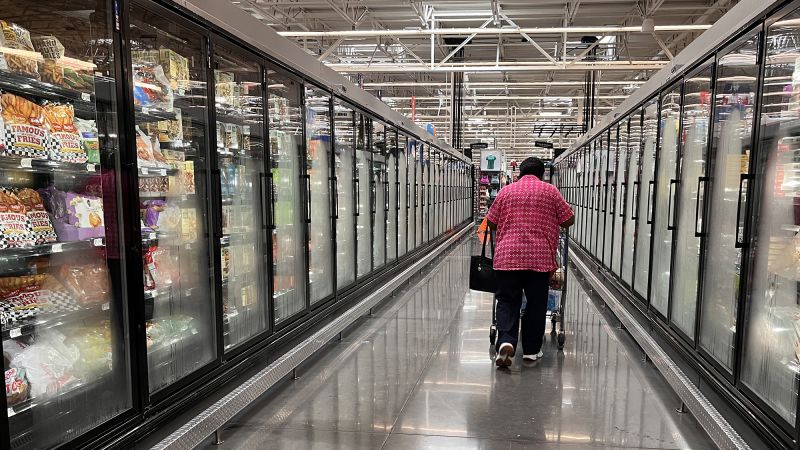A version of this story appeared in CNN Business’ Nightcap newsletter. To get it in your inbox, sign up for free here.
New York
CNN
—
Donald Trump’s pitch to Americans on the campaign trail last year included a simple (and simplistic) promise: lower prices on Day One. Even if he didn’t mean it literally, it’s now Day 115, and the results of his only significant economic policy show that the opposite is happening.
Thursday brought an avalanche of data that all point to one outcome: Prices are going up. Just ask Walmart.
If there’s one company in the world that could theoretically take tariffs on the chin, it’s the world’s biggest retailer, which can (and does) use its scale to pressure suppliers to keep prices low for shoppers. But Walmart said Thursday that US tariffs — as a reminder: those are taxes that American businesses pay on imported goods — are too high, and it is raising prices in response.
“Given the magnitude of the tariffs, even at the reduced levels announced this week, we aren’t able to absorb all the pressure given the reality of narrow retail margins,” Walmart CEO Doug McMillon said Thursday on an earnings call. “The higher tariffs will result in higher prices.”
Walmart has no political incentive to do this — in fact, it’s taking a risk by so publicly tying its price hikes to tariffs, something that Amazon and Mattel learned the hard way tends to enrage the president. And this is not a story of corporate greed run amok, because Walmart would be foolish to try to gouge its customers at a time when economic anxiety is high (more on that in a moment).
This is just what happens when a government puts 10% baseline tariffs on all imports. The money has to come from someone’s pocket, and that someone is generally the company importing the things or the consumer buying the things, or both.
You may be thinking, “Whatever, I went to Walmart/Target/Home Depot this week and everything was fine.” And that’s probably true, because retailers across the board stockpiled as much as they could to get ahead of Trump’s April 2 tariff rollout. But as those inventories wind down, the more-expensive goods ordered after April 2 will hit the shelves. (For Walmart, that’s expected to happen next month.)
Another reason consumers have been insulated: Businesses are already absorbing the costs, according to the latest gauge of US wholesale inflation, known as the Producer Price Index. Last month, wholesale prices actually fell, which sounds like a good thing until you look a little closer at why.
The dip in the PPI came from a plunge in “trade services,” a category that measures profit margins for wholesalers and retailers. Essentially, that means producers are letting higher input costs eat into their profit margins while they try to figure out what to do.
Consumers are in a similar boat. Like the corporations, customers saw tariffs coming and moved quickly to try to front-run them, snapping up cars, electronics and home goods in March.
Now, though, they’re pulling back even more than economists expected. Consumer spending data for April was just barely positive year-over-year, rising 0.1%.
Together, these indicators — Walmart’s price hikes, April wholesale prices and consumer spending data — all tell the same story: The tariff “pain” that Trump warned about (only after taking office) is here.
These indicators are also among the first pieces of “hard data” to confirm that Americans’ behavior is starting to match their mood. (Those things don’t always align. Like when inflation was surging a few years ago, folks tended to tell pollsters that the economy was terrible, but they also continued to spend money like everything was great — aka the vibecession.)
“We are beginning to see the impact of trade policy filtering into the hard data in such a way that it’s impossible to deny that it is now affecting revenues and profit margins for firms,” Joe Brusuelas, chief economist at RSM US, told my colleague Alicia Wallace.
But wait! There’s more. The Silver Foxes of Finance also weighed in Thursday.
Jamie Dimon, the head of America’s largest bank, JPMorgan Chase, told Bloomberg News in an interview that he’s not counting on the US getting out of 2025 recession-free. And he even suggested America’s longstanding status as the world’s financial safe haven is not guaranteed. (“You do not have a divine right to success,” the billionaire bank CEO said.)
Federal Reserve Chair Jerome Powell, meanwhile, warned that “we may be entering a period of more frequent, and potentially more persistent, supply shocks.” (Read: Prices are going to be a lot more volatile, up and down, making it much harder for the central bank to do its job.)
To be sure, there are some areas where prices are actually going down. Eggs, as the president is fond of noting, are getting cheaper. Ditto airfare, gas, sporting event tickets and hotel rooms. Unfortunately, those prices are coming down because demand is going slack. People don’t book vacations when they’re not confident about their income.
Bottom line: We’re in it now, folks.
Stay tuned: Friday adds some fresh “soft data” to our simmering economic stew. Consumer sentiment — what consumers say about how they feel — measured by the University of Michigan has been falling steadily since January. It’s possible, given the timing of the survey, that we may see a bit more optimism in response to last weekend’s unexpected detente with China.
And next week, Target, Home Depot and Lowe’s report earnings and financial forecasts that should tell us more about how tariffs are hitting their bottom lines.

